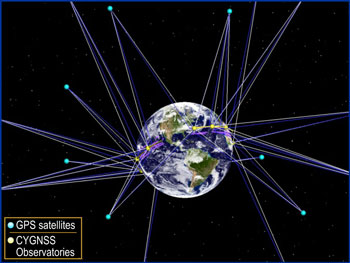CYGNSS Mission
CYGNSS is a NASA Earth Venture mission led by the Department of Climate and Space Sciences and Engineering in the University of Michigan’s College of Engineering. It consists of eight satellites that measure surface wind speed in tropical cyclones to improve storm forecasting. The mission was conceived, designed and implemented by faculty and students in U-M Climate and Space (or CLaSP) and engineers in the Space Physics Research Laboratory at the University of Michigan working with the Southwest Research Institute, Surrey Satellite Technology Ltd., and other subcontractors. CYGNSS is helping to revolutionize the use of small satellite constellations for essential scientific purposes.
CYGNSS Launch and Early Orbit Ops
In the video, Discovery Canada put together this nice overview of the CYGNSS mission launch and early on-obit operations for their Mighty Planes series.
—————————————————————————————————–
Latest News
December 15, 2022
Happy Sixth Birthday to the CYGNSS Constellation
CYGNSS was launched on Dec 15, 2016 and celebrates its sixth birthday today. Over that time, it has grown from a two-year mission measuring winds in major ocean storms into a mission with a broad and expanding variety of goals and objectives. They range from how ocean surface heat flux affects mesoscale convection and precipitation to how wetlands hidden under dense vegetation generate methane in the atmosphere, from how the suppression of ocean surface roughness helps track pollutant abundance in the Great Pacific Garbage Patch to how moist soil under heavy vegetation helps pinpoint locust breeding grounds in East Africa.
For more details:
https://earthobservatory.nasa.gov/blogs/fromthefield/2022/12/15/happy-sixth-birthday-to-the-cygnss-constellation/
—————————————————————————————————–
NASA’s Weather Prediction Project
The Cyclone Global Navigation Satellite System (CYGNSS) aims to improve extreme weather prediction.
CYGNSS will use a constellation of eight small satellites carried to orbit on a single launch vehicle. In orbit, CYGNSS’s eight micro-satellite observatories will receive both direct and reflected signals from Global Positioning System (GPS) satellites. The direct signals pinpoint CYGNSS observatory positions, while the reflected signals respond to ocean surface roughness, from which wind speed is retrieved.
The mission will study the relationship between ocean surface properties, moist atmospheric thermodynamics, radiation and convective dynamics to determine how a tropical cyclone forms and whether or not it will strengthen, and if so by how much. This will advance forecasting and tracking methods.
CYGNSS data will enable scientists, for the first time, to probe key air-sea interaction processes that take place near the inner core of the storms, which are rapidly changing and play large roles in the genesis and intensification of hurricanes.
The CYGNSS mission launched on December 15, 2016!
The CYGNSS mission is comprised of 8 Low Earth Orbiting (LEO) spacecraft (S/C) that receive both direct and reflected signals from GPS satellites.






